engine FIAT DOBLO COMBI 2016 2.G Owners Manual
[x] Cancel search | Manufacturer: FIAT, Model Year: 2016, Model line: DOBLO COMBI, Model: FIAT DOBLO COMBI 2016 2.GPages: 298, PDF Size: 25.92 MB
Page 209 of 298
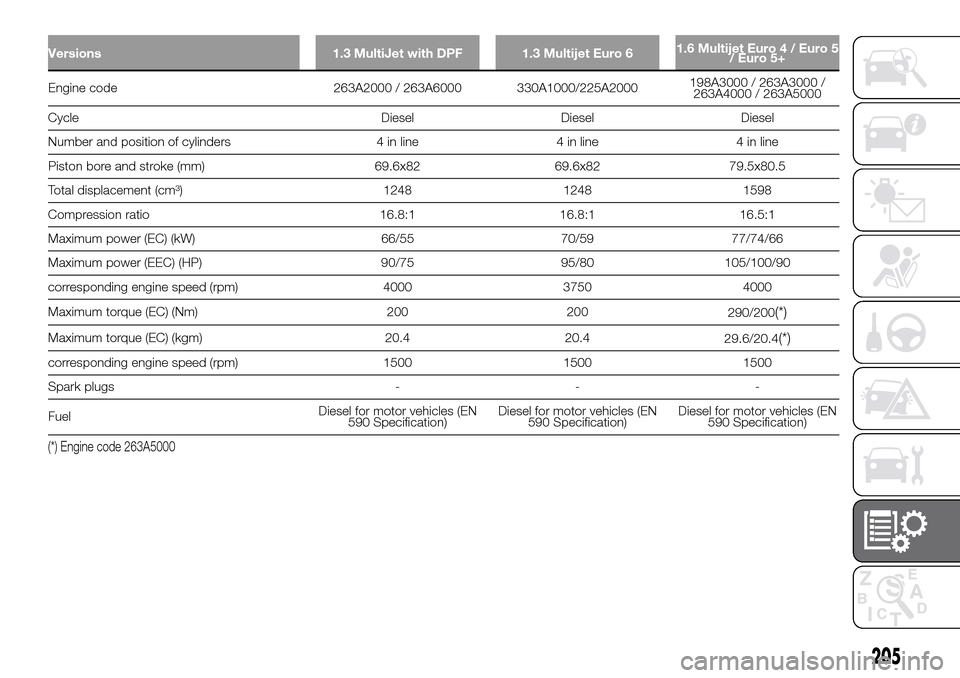
Versions 1.3 MultiJet with DPF 1.3 Multijet Euro 61.6 Multijet Euro 4 / Euro 5
/ Euro 5+
Engine code 263A2000 / 263A6000 330A1000/225A2000198A3000 / 263A3000 /
263A4000 / 263A5000
Cycle Diesel Diesel Diesel
Number and position of cylinders 4 in line 4 in line 4 in line
Piston bore and stroke (mm) 69.6x82 69.6x82 79.5x80.5
Total displacement (cm³) 1248 1248 1598
Compression ratio 16.8:1 16.8:1 16.5:1
Maximum power (EC) (kW) 66/55 70/59 77/74/66
Maximum power (EEC) (HP) 90/75 95/80 105/100/90
corresponding engine speed (rpm) 4000 3750 4000
Maximum torque (EC) (Nm) 200 200
290/200
(*)
Maximum torque (EC) (kgm) 20.4 20.4
29.6/20.4(*)
corresponding engine speed (rpm) 1500 1500 1500
Spark plugs - - -
FuelDiesel for motor vehicles (EN
590 Specification)Diesel for motor vehicles (EN
590 Specification)Diesel for motor vehicles (EN
590 Specification)
(*) Engine code 263A5000
205
Page 210 of 298
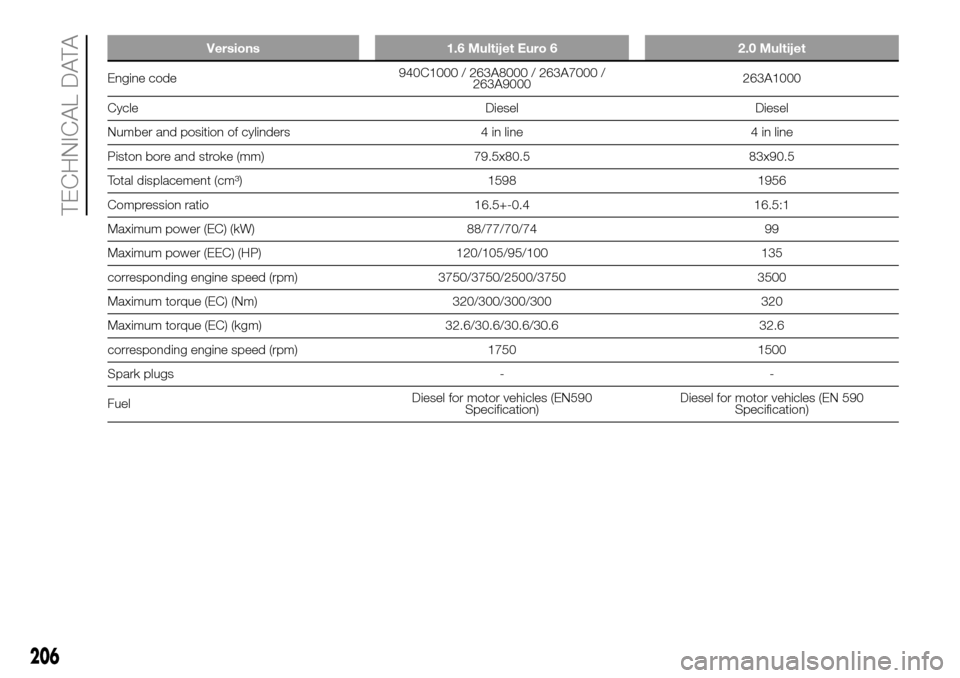
Versions 1.6 Multijet Euro 6 2.0 Multijet
Engine code940C1000 / 263A8000 / 263A7000 /
263A9000263A1000
Cycle Diesel Diesel
Number and position of cylinders 4 in line 4 in line
Piston bore and stroke (mm) 79.5x80.5 83x90.5
Total displacement (cm³) 1598 1956
Compression ratio 16.5+-0.4 16.5:1
Maximum power (EC) (kW) 88/77/70/74 99
Maximum power (EEC) (HP) 120/105/95/100 135
corresponding engine speed (rpm) 3750/3750/2500/3750 3500
Maximum torque (EC) (Nm) 320/300/300/300 320
Maximum torque (EC) (kgm) 32.6/30.6/30.6/30.6 32.6
corresponding engine speed (rpm) 1750 1500
Spark plugs - -
FuelDiesel for motor vehicles (EN590
Specification)Diesel for motor vehicles (EN 590
Specification)
206
TECHNICAL DATA
Page 252 of 298
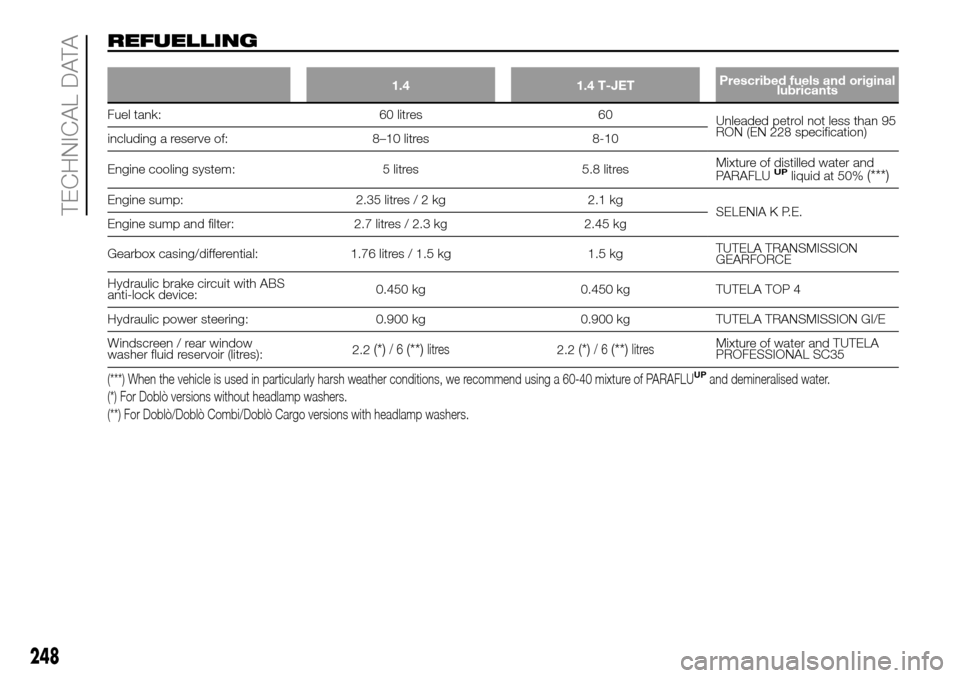
REFUELLING
1.4 1.4 T-JETPrescribed fuels and original
lubricants
Fuel tank: 60 litres 60
Unleaded petrol not less than 95
RON (EN 228 specification)
including a reserve of: 8–10 litres 8-10
Engine cooling system: 5 litres 5.8 litresMixture of distilled water and
PARAFLU
UPliquid at 50%(***)
Engine sump: 2.35 litres/2kg 2.1kg
SELENIA K P.E.
Engine sump and filter: 2.7 litres / 2.3 kg 2.45 kg
Gearbox casing/differential: 1.76 litres / 1.5 kg 1.5 kgTUTELA TRANSMISSION
GEARFORCE
Hydraulic brake circuit with ABS
anti-lock device:0.450 kg 0.450 kg TUTELA TOP 4
Hydraulic power steering: 0.900 kg 0.900 kg TUTELA TRANSMISSION GI/E
Windscreen / rear window
washer fluid reservoir (litres):2.2
(*)/6(**)litres2.2(*)/6(**)litresMixture of water and TUTELA
PROFESSIONAL SC35
(***) When the vehicle is used in particularly harsh weather conditions, we recommend using a 60-40 mixture of PARAFLUUPand demineralised water.
(*) For Doblò versions without headlamp washers.
(**) For Doblò/Doblò Combi/Doblò Cargo versions with headlamp washers.
248
TECHNICAL DATA
Page 253 of 298
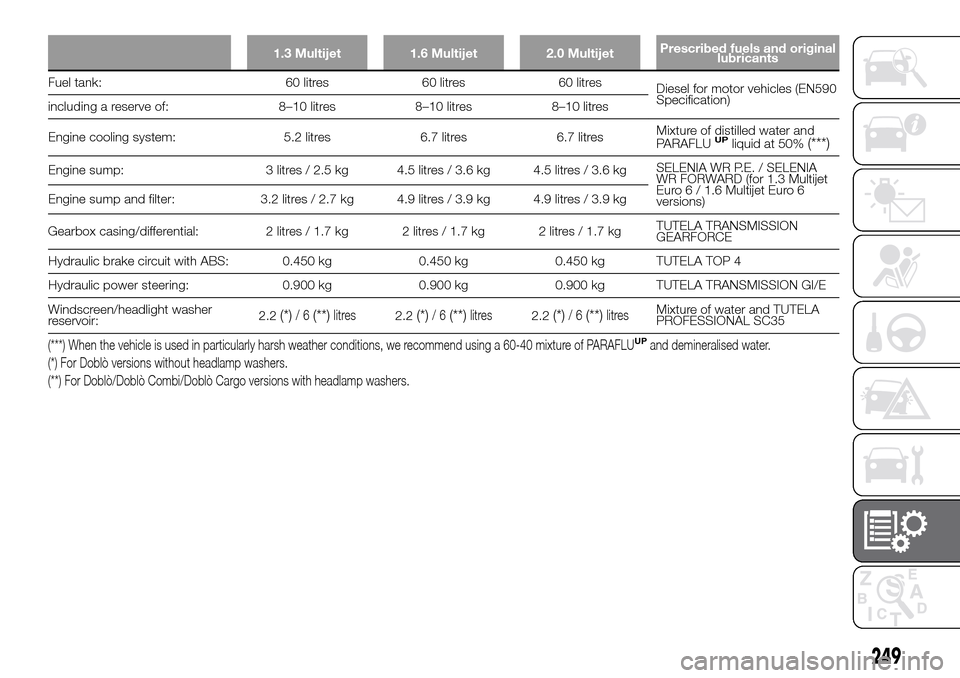
1.3 Multijet 1.6 Multijet 2.0 MultijetPrescribed fuels and original
lubricants
Fuel tank: 60 litres 60 litres 60 litres
Diesel for motor vehicles (EN590
Specification)
including a reserve of: 8–10 litres 8–10 litres 8–10 litres
Engine cooling system: 5.2 litres 6.7 litres 6.7 litresMixture of distilled water and
PARAFLU
UPliquid at 50%(***)
Engine sump: 3 litres / 2.5 kg 4.5 litres / 3.6 kg 4.5 litres / 3.6 kgSELENIA WR P.E. / SELENIA
WR FORWARD (for 1.3 Multijet
Euro 6 / 1.6 Multijet Euro 6
versions) Engine sump and filter: 3.2 litres / 2.7 kg 4.9 litres / 3.9 kg 4.9 litres / 3.9 kg
Gearbox casing/differential: 2 litres / 1.7 kg 2 litres / 1.7 kg 2 litres / 1.7 kgTUTELA TRANSMISSION
GEARFORCE
Hydraulic brake circuit with ABS: 0.450 kg 0.450 kg 0.450 kg TUTELA TOP 4
Hydraulic power steering: 0.900 kg 0.900 kg 0.900 kg TUTELA TRANSMISSION GI/E
Windscreen/headlight washer
reservoir:2.2
(*)/6(**)litres2.2(*)/6(**)litres2.2(*)/6(**)litresMixture of water and TUTELA
PROFESSIONAL SC35
(***) When the vehicle is used in particularly harsh weather conditions, we recommend using a 60-40 mixture of PARAFLUUPand demineralised water.
(*) For Doblò versions without headlamp washers.
(**) For Doblò/Doblò Combi/Doblò Cargo versions with headlamp washers.
249
Page 254 of 298
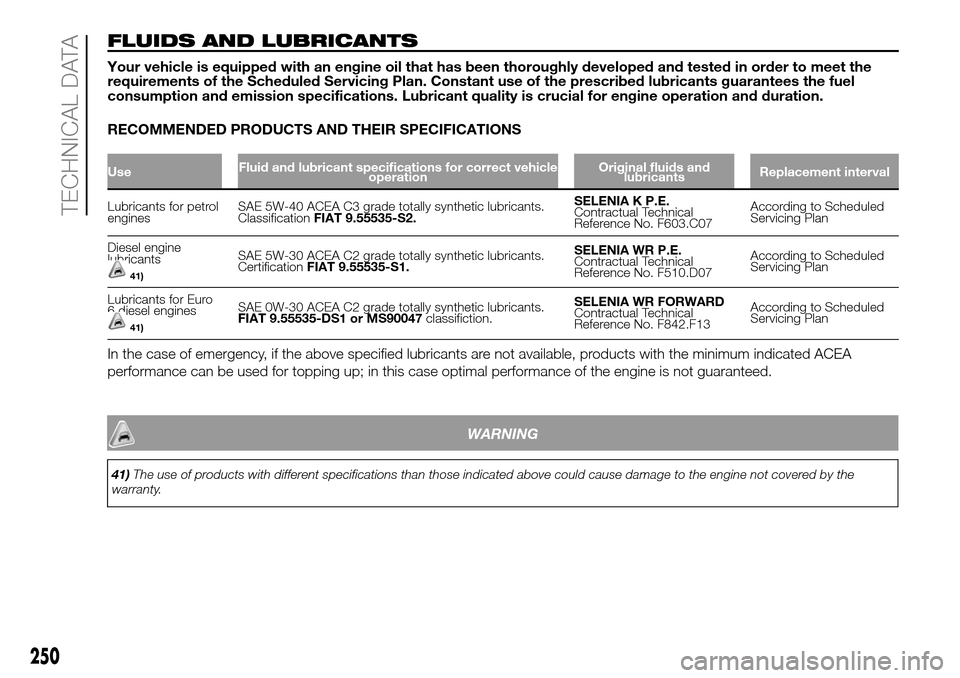
FLUIDS AND LUBRICANTS
Your vehicle is equipped with an engine oil that has been thoroughly developed and tested in order to meet the
requirements of the Scheduled Servicing Plan. Constant use of the prescribed lubricants guarantees the fuel
consumption and emission specifications. Lubricant quality is crucial for engine operation and duration.
RECOMMENDED PRODUCTS AND THEIR SPECIFICATIONS
UseFluid and lubricant specifications for correct vehicle
operationOriginal fluids and
lubricantsReplacement interval
Lubricants for petrol
enginesSAE 5W-40 ACEA C3 grade totally synthetic lubricants.
ClassificationFIAT 9.55535-S2.SELENIA K P.E.
Contractual Technical
Reference No. F603.C07According to Scheduled
Servicing Plan
Diesel engine
lubricants
41)
SAE 5W-30 ACEA C2 grade totally synthetic lubricants.
CertificationFIAT 9.55535-S1.SELENIA WR P.E.
Contractual Technical
Reference No. F510.D07According to Scheduled
Servicing Plan
Lubricants for Euro
6 diesel engines
41)
SAE 0W-30 ACEA C2 grade totally synthetic lubricants.
FIAT 9.55535-DS1 or MS90047classifiction.SELENIA WR FORWARD
Contractual Technical
Reference No. F842.F13According to Scheduled
Servicing Plan
In the case of emergency, if the above specified lubricants are not available, products with the minimum indicated ACEA
performance can be used for topping up; in this case optimal performance of the engine is not guaranteed.
250
TECHNICAL DATA
WARNING
41)The use of products with different specifications than those indicated above could cause damage to the engine not covered by the
warranty.
Page 256 of 298

UseFluid and lubricant specifications for correct vehicle
operationOriginal fluids and
lubricantsApplications
Protective agent for
radiatorsRed protective with antifreeze action, based on inhibited
monoethyl glycol with organic formula. Exceeds CUNA
NC 956-16, ASTM D 3306 specifications.
FIAT 9.55523 classification.PARAFLUUP(*)
Contractual Technical
Reference No. F101.M01Cooling circuits. Use rate
50% up to -35°C. Mixture
with different formulation
products not allowed.
Diesel fuel additive Additive for diesel antifreeze, protecting diesel engines.TUTELA DIESEL ART
Contractual Technical
Reference No. F601.L06To be mixed with diesel
(25 cc per 10 litres)
Windscreen washer
fluidMixture of alcohol and surfactants CUNA NC 956-II.
FIAT 9.55522 classification.TUTELA PROFESSIONAL
SC 35
Contractual Technical
Reference No. F201.D02To be used diluted or
undiluted in windscreen
washer/wiper systems
(*)When the vehicle is used in particularly harsh weather conditions, we recommend using a mixture of 60%PARAFLUUPand 40% demineralised water.
252
TECHNICAL DATA
Page 258 of 298
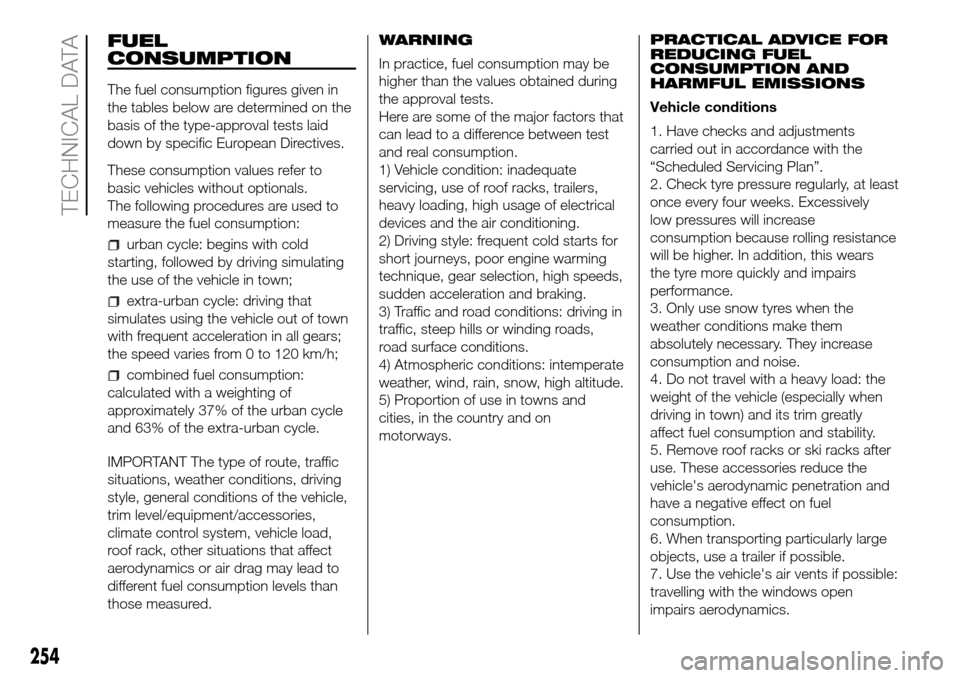
FUEL
CONSUMPTION
The fuel consumption figures given in
the tables below are determined on the
basis of the type-approval tests laid
down by specific European Directives.
These consumption values refer to
basic vehicles without optionals.
The following procedures are used to
measure the fuel consumption:
urban cycle: begins with cold
starting, followed by driving simulating
the use of the vehicle in town;
extra-urban cycle: driving that
simulates using the vehicle out of town
with frequent acceleration in all gears;
the speed varies from 0 to 120 km/h;
combined fuel consumption:
calculated with a weighting of
approximately 37% of the urban cycle
and 63% of the extra-urban cycle.
IMPORTANT The type of route, traffic
situations, weather conditions, driving
style, general conditions of the vehicle,
trim level/equipment/accessories,
climate control system, vehicle load,
roof rack, other situations that affect
aerodynamics or air drag may lead to
different fuel consumption levels than
those measured.WARNING
In practice, fuel consumption may be
higher than the values obtained during
the approval tests.
Here are some of the major factors that
can lead to a difference between test
and real consumption.
1) Vehicle condition: inadequate
servicing, use of roof racks, trailers,
heavy loading, high usage of electrical
devices and the air conditioning.
2) Driving style: frequent cold starts for
short journeys, poor engine warming
technique, gear selection, high speeds,
sudden acceleration and braking.
3) Traffic and road conditions: driving in
traffic, steep hills or winding roads,
road surface conditions.
4) Atmospheric conditions: intemperate
weather, wind, rain, snow, high altitude.
5) Proportion of use in towns and
cities, in the country and on
motorways.PRACTICAL ADVICE FOR
REDUCING FUEL
CONSUMPTION AND
HARMFUL EMISSIONS
Vehicle conditions
1. Have checks and adjustments
carried out in accordance with the
“Scheduled Servicing Plan”.
2. Check tyre pressure regularly, at least
once every four weeks. Excessively
low pressures will increase
consumption because rolling resistance
will be higher. In addition, this wears
the tyre more quickly and impairs
performance.
3. Only use snow tyres when the
weather conditions make them
absolutely necessary. They increase
consumption and noise.
4. Do not travel with a heavy load: the
weight of the vehicle (especially when
driving in town) and its trim greatly
affect fuel consumption and stability.
5. Remove roof racks or ski racks after
use. These accessories reduce the
vehicle's aerodynamic penetration and
have a negative effect on fuel
consumption.
6. When transporting particularly large
objects, use a trailer if possible.
7. Use the vehicle's air vents if possible:
travelling with the windows open
impairs aerodynamics.
254
TECHNICAL DATA
Page 259 of 298
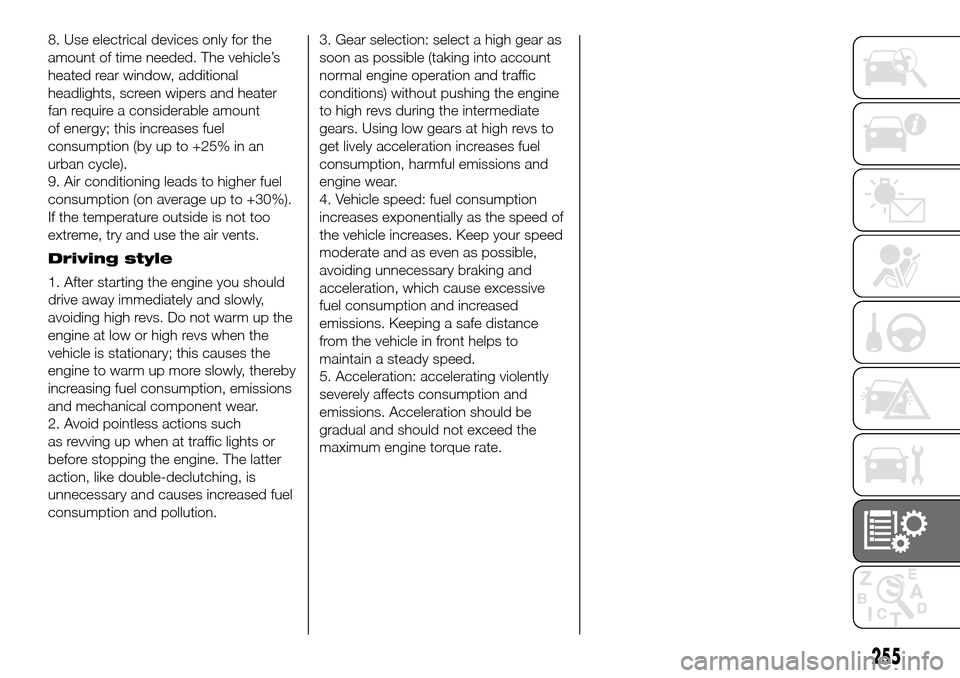
8. Use electrical devices only for the
amount of time needed. The vehicle’s
heated rear window, additional
headlights, screen wipers and heater
fan require a considerable amount
of energy; this increases fuel
consumption (by up to +25% in an
urban cycle).
9. Air conditioning leads to higher fuel
consumption (on average up to +30%).
If the temperature outside is not too
extreme, try and use the air vents.
Driving style
1. After starting the engine you should
drive away immediately and slowly,
avoiding high revs. Do not warm up the
engine at low or high revs when the
vehicle is stationary; this causes the
engine to warm up more slowly, thereby
increasing fuel consumption, emissions
and mechanical component wear.
2. Avoid pointless actions such
as revving up when at traffic lights or
before stopping the engine. The latter
action, like double-declutching, is
unnecessary and causes increased fuel
consumption and pollution.3. Gear selection: select a high gear as
soon as possible (taking into account
normal engine operation and traffic
conditions) without pushing the engine
to high revs during the intermediate
gears. Using low gears at high revs to
get lively acceleration increases fuel
consumption, harmful emissions and
engine wear.
4. Vehicle speed: fuel consumption
increases exponentially as the speed of
the vehicle increases. Keep your speed
moderate and as even as possible,
avoiding unnecessary braking and
acceleration, which cause excessive
fuel consumption and increased
emissions. Keeping a safe distance
from the vehicle in front helps to
maintain a steady speed.
5. Acceleration: accelerating violently
severely affects consumption and
emissions. Acceleration should be
gradual and should not exceed the
maximum engine torque rate.
255
Page 284 of 298
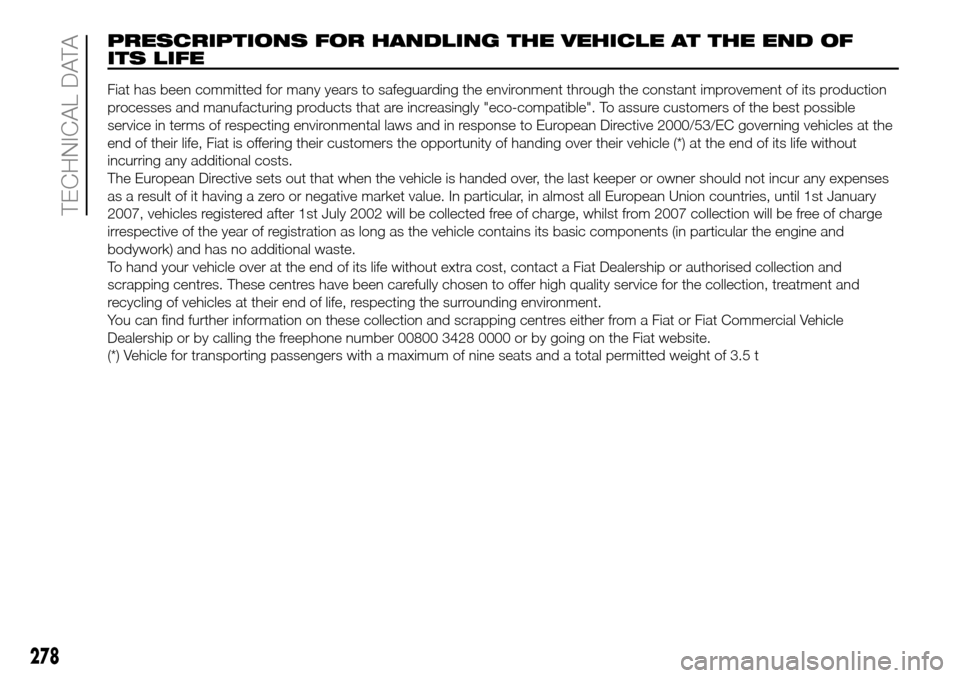
PRESCRIPTIONS FOR HANDLING THE VEHICLE AT THE END OF
ITS LIFE
Fiat has been committed for many years to safeguarding the environment through the constant improvement of its production
processes and manufacturing products that are increasingly "eco-compatible". To assure customers of the best possible
service in terms of respecting environmental laws and in response to European Directive 2000/53/EC governing vehicles at the
end of their life, Fiat is offering their customers the opportunity of handing over their vehicle (*) at the end of its life without
incurring any additional costs.
The European Directive sets out that when the vehicle is handed over, the last keeper or owner should not incur any expenses
as a result of it having a zero or negative market value. In particular, in almost all European Union countries, until 1st January
2007, vehicles registered after 1st July 2002 will be collected free of charge, whilst from 2007 collection will be free of charge
irrespective of the year of registration as long as the vehicle contains its basic components (in particular the engine and
bodywork) and has no additional waste.
To hand your vehicle over at the end of its life without extra cost, contact a Fiat Dealership or authorised collection and
scrapping centres. These centres have been carefully chosen to offer high quality service for the collection, treatment and
recycling of vehicles at their end of life, respecting the surrounding environment.
You can find further information on these collection and scrapping centres either from a Fiat or Fiat Commercial Vehicle
Dealership or by calling the freephone number 00800 3428 0000 or by going on the Fiat website.
(*) Vehicle for transporting passengers with a maximum of nine seats and a total permitted weight of 3.5 t
278
TECHNICAL DATA
Page 294 of 298
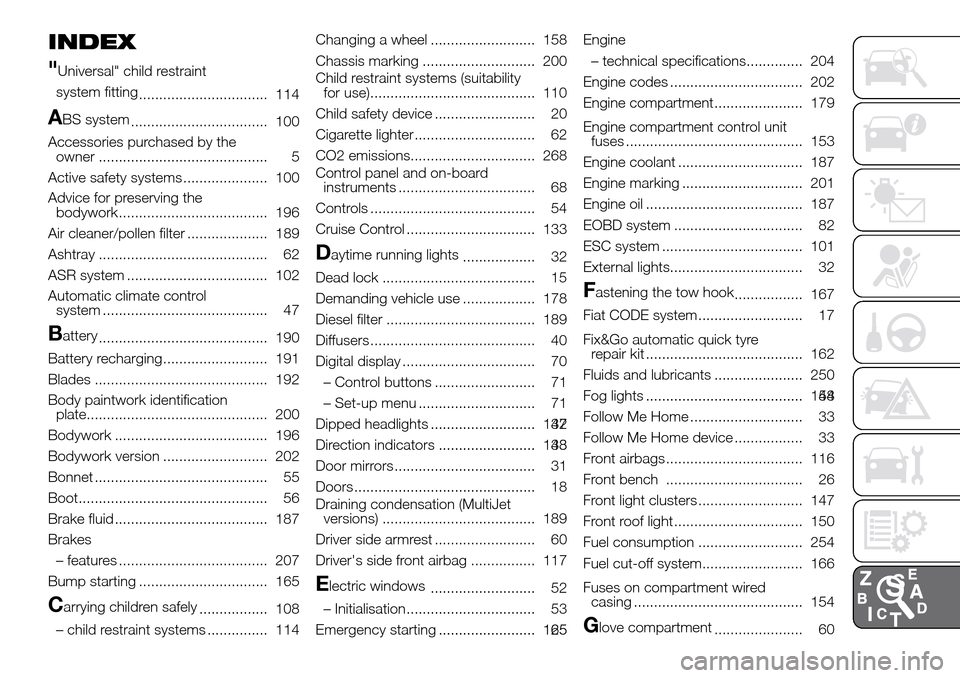
INDEX
"
Universal" child restraint
system fitting
................................ 114
ABS system
.................................. 100
Accessories purchased by the
owner .......................................... 5
Active safety systems ..................... 100
Advice for preserving the
bodywork..................................... 196
Air cleaner/pollen filter .................... 189
Ashtray .......................................... 62
ASR system ................................... 102
Automatic climate control
system ......................................... 47
Battery
.......................................... 190
Battery recharging.......................... 191
Blades ........................................... 192
Body paintwork identification
plate............................................. 200
Bodywork ...................................... 196
Bodywork version .......................... 202
Bonnet ........................................... 55
Boot............................................... 56
Brake fluid ...................................... 187
Brakes
– features ..................................... 207
Bump starting ................................ 165
Carrying children safely
................. 108
– child restraint systems ............... 114Changing a wheel .......................... 158
Chassis marking ............................ 200
Child restraint systems (suitability
for use)......................................... 110
Child safety device ......................... 20
Cigarette lighter .............................. 62
CO2 emissions............................... 268
Control panel and on-board
instruments .................................. 68
Controls ......................................... 54
Cruise Control ................................ 133
Daytime running lights
.................. 32
Dead lock ...................................... 15
Demanding vehicle use .................. 178
Diesel filter ..................................... 189
Diffusers ......................................... 40
Digital display ................................. 70
– Control buttons ......................... 71
– Set-up menu ............................. 71
Dipped headlights .......................... 32.......................... 147
Direction indicators ........................ 33........................ 148
Door mirrors ................................... 31
Doors ............................................. 18
Draining condensation (MultiJet
versions) ...................................... 189
Driver side armrest ......................... 60
Driver's side front airbag ................ 117
Electric windows
.......................... 52
– Initialisation................................ 53
Emergency starting ........................ 125........................ 165Engine
– technical specifications.............. 204
Engine codes ................................. 202
Engine compartment...................... 179
Engine compartment control unit
fuses ............................................ 153
Engine coolant ............................... 187
Engine marking .............................. 201
Engine oil ....................................... 187
EOBD system ................................ 82
ESC system ................................... 101
External lights................................. 32
Fastening the tow hook
................. 167
Fiat CODE system.......................... 17
Fix&Go automatic quick tyre
repair kit ....................................... 162
Fluids and lubricants ...................... 250
Fog lights ....................................... 54....................................... 148
Follow Me Home ............................ 33
Follow Me Home device ................. 33
Front airbags .................................. 116
Front bench .................................. 26
Front light clusters .......................... 147
Front roof light ................................ 150
Fuel consumption .......................... 254
Fuel cut-off system......................... 166
Fuses on compartment wired
casing .......................................... 154
Glove compartment
...................... 60